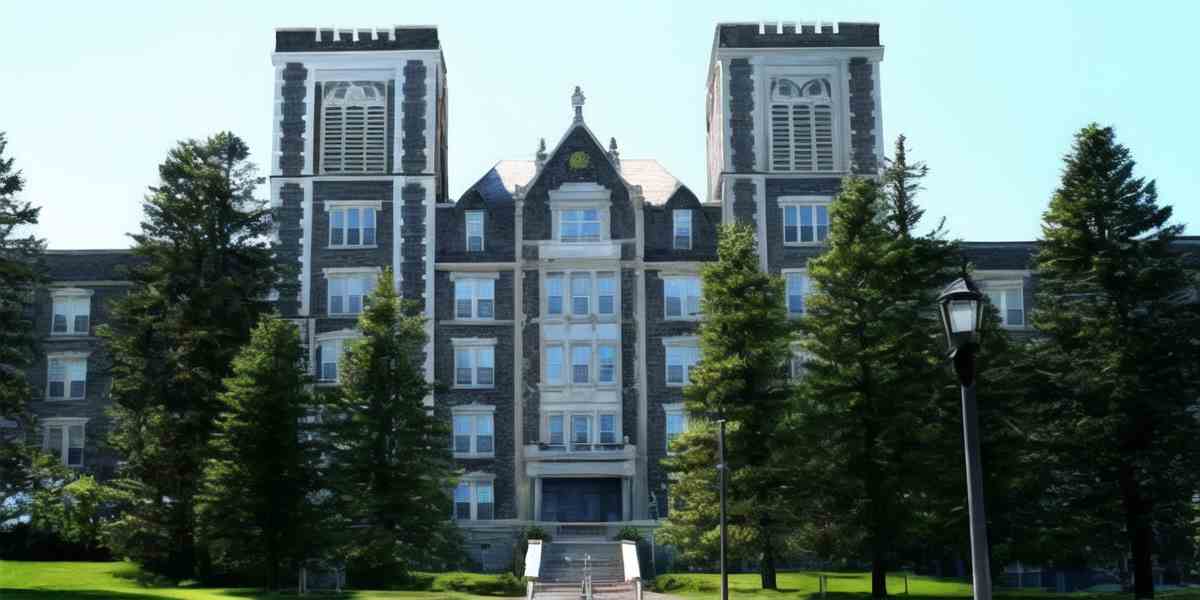The College of Saint Scholastica
2024 USNews Best Colleges Ranking: 216(↑18) (Click for schools/majors ranking)
School Characteristics: Private, non-Profit (4-Years)
Calendar systerm: Semester
Religious Affiliation: Roman Catholic
School Chief: Barbara McDonald (President)
Website: www.css.edu/; Phone: 2187236000
Location: 1200 Kenwood Ave, Duluth, MN, 55811-4199

The College of Saint Scholastica Important Facts
The College of Saint Scholastica Degrees and Majors
The College of Saint Scholastica Ranking and Admission
The College of Saint Scholastica Admission Score Requires
*Numbers at left represent SAT/ACT submitting percentage, numbers on blue blocks represent 25%-75% admission scores
**Drag green block to check data for different years, click blue block to check scores trends
The College of Saint Scholastica Students Diversity
The College of Saint Scholastica Students Age Distribution
The College of Saint Scholastica International Students Trends
The College of Saint Scholastica Campus and Safety
Nearby Top Colleges
Campus Safety
Reference
- The College of Saint Scholastica Official Website
- USNews Best Colleges Ranking
- USNews Bset Global Universities Ranking
- THE World University Ranking
- QS World University Ranking
- ARWU World University Ranking
- US Department of Education College Scorecard
- National Center for Education Statistics
- Forward Pathway US College Ranking Database
 The College of Saint Scholastica Important Facts Trends
The College of Saint Scholastica Important Facts Trends
 The College of Saint Scholastica degrees/majors
The College of Saint Scholastica degrees/majors
The College of Saint Scholastica major details
*Depends on whether majors have graduates in 2022 or not, Yes / No
**Move mouse on can check deitaled graudates number, click for major detailed information
***Due to privacy policy, graduate salaries are not shown for some majors that has few gradautes
| Major | Graduate Salary | Under | Master | Doctor |
|---|---|---|---|---|
| Health Services/Allied Health/Health Sciences, General. | $55,567 | |||
| Health Information/Medical Records Administration/Administrator. | $57,858-$68,203 | |||
| Physician Assistant. | $49,895 | |||
| Athletic Training/Trainer. | $49,895 | |||
| Occupational Therapy/Therapist. | $64,898-$78,468 | |||
| Physical Therapy/Therapist. | $64,898-$78,468 | |||
| Medical Informatics. | - | |||
| Holistic/Integrative Health. | - | |||
| Registered Nursing/Registered Nurse. | $75,350-$117,113 | |||
| Nursing Practice. | $75,350-$117,113 |
| Major | Graduate Salary | Under | Master | Doctor |
|---|---|---|---|---|
| Business/Commerce, General. | $82,880 | |||
| Business Administration and Management, General. | $57,358-$80,461 | |||
| Project Management. | $57,358-$80,461 | |||
| Accounting. | $57,746 | |||
| Finance, General. | - | |||
| Organizational Behavior Studies. | $51,154 | |||
| Management Science. | - | |||
| Marketing/Marketing Management, General. | $52,354 |
| Major | Graduate Salary | Under | Master | Doctor |
|---|---|---|---|---|
| Administration of Special Education. | - | |||
| Elementary Education and Teaching. | $53,578 | |||
| Teacher Education, Multiple Levels. | $53,578 | |||
| Teacher Education and Professional Development, Specific Levels and Methods, Other. | $53,578 | |||
| English/Language Arts Teacher Education. | - | |||
| Social Studies Teacher Education. | - | |||
| Biology Teacher Education. | - |
| Major | Graduate Salary | Under | Master | Doctor |
|---|---|---|---|---|
| Social Work. | $48,482-$63,146 |
| Major | Graduate Salary | Under | Master | Doctor |
|---|---|---|---|---|
| Biology/Biological Sciences, General. | $72,626 | |||
| Biochemistry. | - | |||
| Exercise Physiology and Kinesiology. | $48,680 |
| Major | Graduate Salary | Under | Master | Doctor |
|---|---|---|---|---|
| Psychology, General. | $50,740 |
| Major | Graduate Salary | Under | Master | Doctor |
|---|---|---|---|---|
| Computer and Information Sciences, General. | $79,084 |
| Major | Graduate Salary | Under | Master | Doctor |
|---|---|---|---|---|
| Communication, General. | - |
| Major | Graduate Salary | Under | Master | Doctor |
|---|---|---|---|---|
| Chemistry, General. | - | |||
| Physical Sciences, Other. | - |
| Major | Graduate Salary | Under | Master | Doctor |
|---|---|---|---|---|
| Peace Studies and Conflict Resolution. | - | |||
| International/Globalization Studies. | - | |||
| Sustainability Studies. | - |
| Major | Graduate Salary | Under | Master | Doctor |
|---|---|---|---|---|
| Philosophy. | - |
| Major | Graduate Salary | Under | Master | Doctor |
|---|---|---|---|---|
| English Language and Literature, General. | - |
| Major | Graduate Salary | Under | Master | Doctor |
|---|---|---|---|---|
| Art/Art Studies, General. | - | |||
| Music Performance, General. | - |
| Major | Graduate Salary | Under | Master | Doctor |
|---|---|---|---|---|
| Humanities/Humanistic Studies. | - |
| Major | Graduate Salary | Under | Master | Doctor |
|---|---|---|---|---|
| History, General. | - |
| Major | Graduate Salary | Under | Master | Doctor |
|---|---|---|---|---|
| Mathematics, General. | - |
| Major | Graduate Salary | Under | Master | Doctor |
|---|---|---|---|---|
| Spanish Language and Literature. | - |
 The College of Saint Scholastica Schools/Majors Ranking
The College of Saint Scholastica Schools/Majors Ranking
Under Ranking (2024)
*Rankings have been updated to 2025USNews schools/majors ranking, rankings are for reference only
*numbers in bracket represent rankings change compare to last version
 The College of Saint Scholastica Varsity Athletes
The College of Saint Scholastica Varsity Athletes
| NCAA Division III with football | MEN | WOMEN |
|---|---|---|
| Football | 73 | - |
| Soccer | 31 | 33 |
| Ice Hockey | 27 | 26 |
| Cross Country | 23 | 24 |
| Track and Field (Indoor) | 26 | 15 |
| Track and Field (Outdoor) | 23 | 18 |
| Skiing | 18 | 17 |
| Basketball | 20 | 13 |
| Baseball | 32 | - |
| Tennis | 12 | 14 |
| Softball | - | 19 |
| Golf | 9 | 7 |
| Volleyball | - | 15 |
| NCAA Division III with football | MEN | WOMEN |
|---|---|---|
| Soccer | 30 | 28 |
| Ice Hockey | 30 | 26 |
| Track and Field, Outdoor | 26 | 19 |
| Skiing | 22 | 16 |
| Basketball | 20 | 13 |
| Baseball | 31 | - |
| Track and Field, Indoor | 16 | 14 |
| Softball | - | 25 |
| Tennis | 12 | 12 |
| Golf | 7 | 10 |
| Volleyball | - | 17 |
| NCAA Division III with football | MEN | WOMEN |
|---|---|---|
| Soccer | 29 | 44 |
| Track and Field, Indoor | 27 | 31 |
| Track and Field, Outdoor | 29 | 28 |
| Ice Hockey | 31 | 23 |
| Track and Field, X-Country | 31 | 21 |
| Football | 47 | - |
| Skiing | 22 | 15 |
| Basketball | 18 | 15 |
| Baseball | 32 | - |
| Tennis | 12 | 13 |
| Softball | - | 19 |
| Golf | 8 | 9 |
| Volleyball | - | 16 |
| Weight Lifting | - | - |
| Equestrian | - | - |
| Table Tennis | - | - |
| Water Polo | - | - |
| Wrestling | - | - |
| Other Sports | - | - |
| Archery | - | - |
| Sailing | - | - |
| Rodeo | - | - |
| Badminton | - | - |
| Beach Volleyball | - | - |
| Bowling | - | - |
| Team Handball | - | - |
| Synchronized Swimming | - | - |
| Swimming | - | - |
| Swimming and Diving | - | - |
| Squash | - | - |
| Rowing | - | - |
| Rifle | - | - |
| Lacrosse | - | - |
| Gymnastics | - | - |
| Field Hockey | - | - |
| Fencing | - | - |
| Diving | - | - |
| All Track Combined | - | - |

 The College of Saint Scholastica Important Facts Trends
The College of Saint Scholastica Important Facts Trends
















































































































































































































































































































































































































































